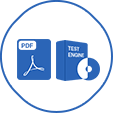Last Update 8 hours ago Total Questions : 685
The Certified Professional in Healthcare Quality Examination content is now fully updated, with all current exam questions added 8 hours ago. Deciding to include CPHQ practice exam questions in your study plan goes far beyond basic test preparation.
You'll find that our CPHQ exam questions frequently feature detailed scenarios and practical problem-solving exercises that directly mirror industry challenges. Engaging with these CPHQ sample sets allows you to effectively manage your time and pace yourself, giving you the ability to finish any Certified Professional in Healthcare Quality Examination practice test comfortably within the allotted time.
Ahealthcare quality professional has the following data on a hospital's surgical site infection rates:
Procedure
Hospital Infection Rate
95% Confidence Interval
State Mean Infection Rate
Total Hip Replacement
0.4%
0.2%-0.6%
0.9%
Total Knee Replacement
1.1%
0.8%-1.2%
1.0%
ACL Reconstruction
1.5%
1.4%-1.6%
1.5%
Total Shoulder Replacement
1.3%
1.0%-1.6%
0.9%
Which procedure is the best area for focused quality improvement?
A pulmonologist is gathering social determinants of health data from their patients. Which of the following best explains the purpose of collecting this data?
A national health plan has recently acquired a local health plan. At the year anniversary of the merger, the -local health plan staff still struggles with the transition to the new organizational values. Which of the following Is the most likely explanation for the difficulty?
An ambulatory care practice has reviewed data to identify patients with multiple visits to the emergency room within the last six months. The population health management technique for this type of data review is called
A healthcare organization has Introduced an Initiative to Increase lung cancer screenings for Itspatient population with a history of smoking. This screening would fall into which of the following types of prevention?
Which of the following should be used to show beginning and ending times for an activity along a timeline?
Which of the following is the most effective method to identify adverse events that cause harm to patients?
A root cause analysts (RCA) was conducted tor an event related to a delayed high-priority alarm response. Alarm fatigue was determined to be a root cause. Which of the following Is the most appropriate first Intervention?
A rapid cycleimprovement team has met for six months. The team set a clear aim, gathered data, and identified barriers, but has not conducted any tests of change. Team members are also not completing assignments. Which of the following tools should be used to get the team back on track?
In a quality improvement team, the primary role of the facilitator Is to
Who is responsible for aligning resources and ensuring accountability in an improvement project?
A performance improvement coordinator is having difficulty keeping a new team focused on its goal of decreasing patient waiting times. To understand why the team process is not working, the team leader shouldinitially assess the

